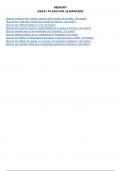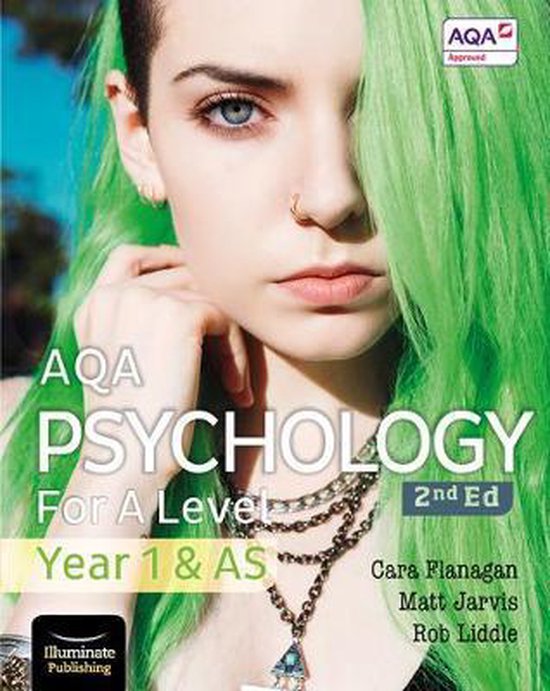MEMORY
ESSAY PLANS FOR 16 MARKERS
Discuss research into coding, capacity and duration of memory. (16 marks)
Discuss the multi-store model as a model of memory. (16 marks)
Discuss the different types of LTM. (16 marks)
Discuss the working memory model (WMM) as a model of memory. (16 marks)
Discuss interference as an explanation for forgetting. (16 marks)
Discuss retrieval failure as an explanation for forgetting. (16 marks)
Discuss the effects of misleading information on the accuracy of EWT. (16 marks)
Discuss the effects of anxiety on accuracy of eyewitness testimony. (16 marks)
Discuss the cognitive interview in improving eyewitness testimony. (16 marks)
, Discuss research into coding, capacity and duration of memory. (16 marks)
- Coding was investigated by Baddeley (1996), giving 4 groups different types of words to recall;
acoustically similar, acoustically different, semantically similar, semantically different
- Baddeley then asked them to recall instantly then 20 minutes later, finding that STM recall was
better with acoustically different words, suggesting STM has acoustic coding, and that LTM recall
was better with semantically different words suggesting LTM coding is semantic
One limitation of Baddeley’s study is that it used artificial stimuli when investigating coding
- The use of words in the studying of coding memory is a weakness because they lack any
meaning to the participants, therefore the semantic coding is likely not tested
- As a consequence, the studying of semantic coding lacks relevance in this study because the
actual meaning of the stimuli has no weight
- Therefore there is limited generalisability of the findings of coding of LTM, decreasing the
explanatory power and utility of Baddeley’s research
- Capacity was investigated by Jacobs (1887), investigating digit span of STM by giving increasing
numbers of digits to participants finding the mean was 9.3 for numbers and was 7.3 for letters
- Chunking was suggested by Miller (1956), stating that items often comes in 7s, suggesting that the
STM recall capacity was 7 items; however also found 5 items can be recalled by chunking
One limitation of Jacobs’ study is that it is likely low in control
- When conducting psychological experiments alongside the emergence of psychology, the
scientific principles of controlling confounding variables were not entirely important in research
- This is a weakness as Jacobs’ participants may have been distracted during the study, so their
memory and recall would likely be reduced, deflating the abilities of capacity of memory stores
- Therefore, Jacobs’ study has low internal validity as the studying of memory capacity with low
control of variables altering recall performance would be inaccurate and deflate results
One limitation of Miller’s research is that it has been criticised for overestimating the capacity of STM
- Research contradictions showcase that STM capacity is much lower than suggested by Miller
- For example, Cowan (2001) reviewed multiple studies finding that the capacity of STM was
better represented around 4 chunks
- This is a weakness as it suggests that Miller’s conclusions overinflated the capacity of STM,
suggesting that the application of his research should be cautious and reconsidered
- Duration was investigated by Peterson and Peterson (1959), giving 24 students a trigram and
asked to count backwards and then had to recall every 3 seconds, STM retention was 18 seconds
- Bahrick et al. (1975) investigated LTM duration, studying 17-74 year olds, giving them photo
recognition tasks and free recall tasks of people in their yearbook, finding LTM can last up to 50y
One strength of Bahrick et al. research on LTM duration is that it has effective methodology
+ Bahrick’s methodology used meaningful stimuli of yearbook pictures and free recall of names
and people that are known by the participants, which is reflective of real life recall
+ This means that the study has high mundane realism as the stimuli are relevant to everyday
long term memory recall showing that it is accurate
+ As a result this increases the internal validity of Bahrick’s study as the stimuli reflect real life
stimuli therefore showcasing that the recall of LTM is being relevantly tested in this study
One limitation of Peterson and Peterson’s research is that it uses artificial stimuli in its method.
- The use of artificial stimuli, like trigrams, is somewhat irrelevant to real life memory functions
as people attach meaning to their memories therefore the STM duration is underestimated
- This reduces the external validity of the research, as applying this doesn’t reflect real life STM





